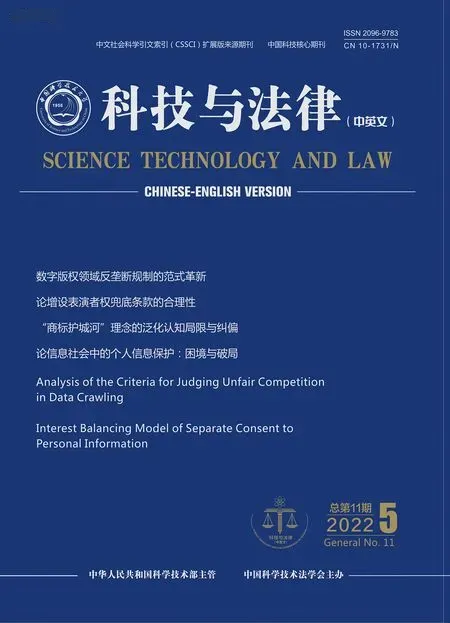Analysis of the Criteria for Judging Unfair Competition in Data Crawling
Zheng Xuanyu,Haoriwa(Civil,Commercial and Economic Law School,China University of Political Science and Law,Beijing 100088,China)
Abstract:Traditional cases consider competitive relations,competitive interests and competitive damages in judging unfair competition.Data crawling cases present additional factors to consider in these three aspects,which deserve further analysis and optimization.A reasonable boundary for the identification of data crawling unfair competition should be established while avoiding the plaintiff's absolute monopoly on data and providing space for innovation and creativity in the subsequent development of data products.In judging whether data crawling constitutes unfair competition conduct,if there is direct competitive relation,it will be applied first,otherwise indirect competitive relation should be applied;and the legitimacy of the plaintiff's collection and use of the data,as well as the legitimacy of the defendant's post-crawling use of the data,need to be considered.
Keywords:data crawling;unfair competition;judicial identification
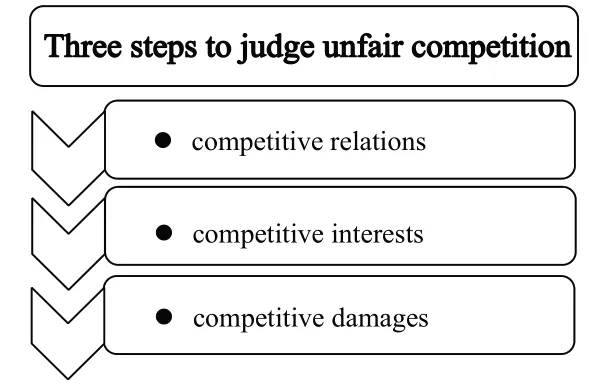
Figure 1
Data crawling unfair competition is also one of the untyped acts.More to the point,the reasons why these three steps are all indispensable for judging unfair competition in data crawling are as follows:(1)In general unfair competition cases,competitive relation is considered to reasonably limit the boundary of identifying unfair competition;in data crawling unfair competition cases,competitive relation is considered because data crawling is likely to occur between competitors in different industries.(2)In general unfair competition cases,the competitive interests enjoyed by the plaintiff often belong to itself;in data crawling unfair competition cases,competitive interest is considered because data is not exclusive to any competitor.(3)In general unfair competition cases,only the damage of the act itself needs to be considered;in data crawling unfair competition cases,competitive damage is considered because,in addition to the act of data crawling,there are subsequent acts of use.In short,in the case of unfair competition in data crawling,there are particular features in the competitive relations between the two parties in dispute,the plaintiff's competitive interest in the data and the damage caused by the defendant's data crawling,which requires specific criteria to be established when applying these three steps.
1 Analysis of Competitive Relations
1.1 Different Interpretations of Direct Competitive Relations
Unfair competition cases can be divided into three categories:traditional unfair competition cases,other Internet unfair competition cases,and data crawling unfair competition cases(See Figure2).Other Internet unfair competition cases and data crawling cases are both related to the Internet,but for the sake of precision,data crawling cases are separated into a single category.Meanwhile,other Internet cases are not relevant to the subject of this article and will not be discussed here.In traditional unfair competition cases,a competitive relation is regarded as a prerequisite for establishing unfair competition.Generally speaking,competitive relations are divided into two categories:direct competitive relations,i.e.relations arising between competitors in the same or related fields of operation;and indirect competitive relations,i.e.relations arising between competitors who are not in the same industry and may compete with each other for other aspects such as trading opportunities and competitive benefits.It is generally accepted that in judicial practice,the competitive relation is the logical starting point for the establishment of unfair competition,however,there are also a few views that the competitive relation is not a factor that must be considered for the establishment of unfair competition.The controversy over whether the competitive relation is the logical starting point is even more pronounced in data crawling cases.For data crawling unfair competition cases,as the parties involved are mainly network operators,the boundaries of their business scope are gradually blurred or even crossed and overlapped,so it is inevitable to break through the direct competitive relations in traditional unfair competition cases.
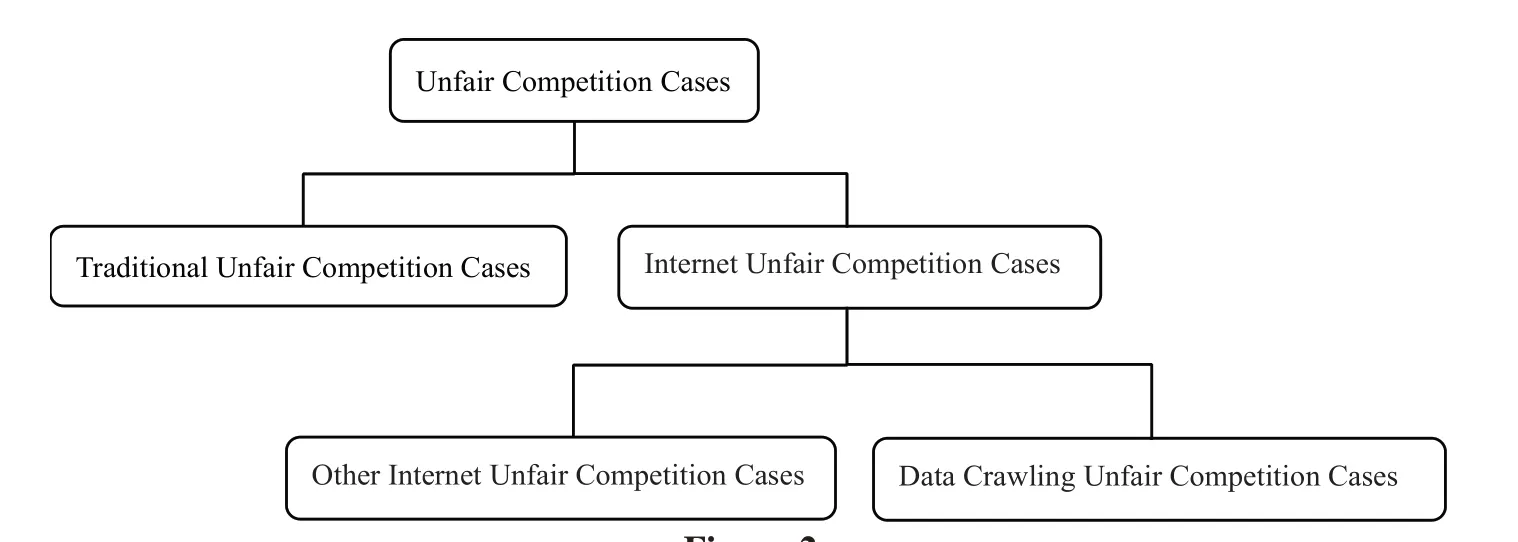
Figure 2
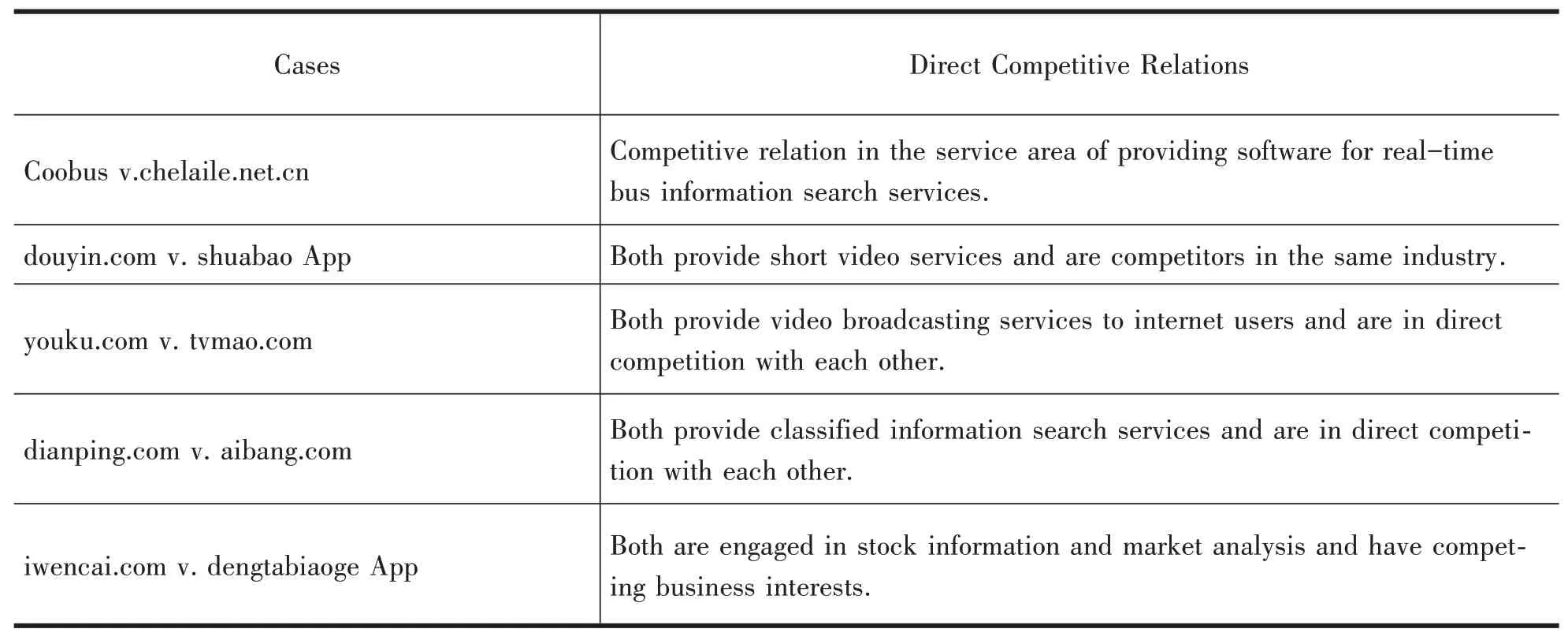
Table 1 Examples of Cases in Which Direct Competitive Relations Were Found

Table 2 Examples of Cases in Which Indirect Competitive Relations Were Found
In short,the defense of non-competition on the basis of different businesses,types of services,and user groups was generally not upheld by the courts.The existence of indirect competitive relations has been recognized as a basis for adjudication in both judicial interpretation and practice.
1.2 Optimization for Identifying Competitive Relations
There are currently three views on the status of competitive relations in the identification of unfair competition:(1)to identify direct and indirect competitive relations in a way that the former takes precedence if there is the former,otherwise,the latter is applied;(2)to consider direct competitive relations in combination with other relevant elements;(3)to disregard competitive relations in the identification of unfair competition.Considering the specificity of data crawling cases,this article argues that the first view should be adopted in data crawling cases,which has the advantage of enabling cases with a direct competitive relation to be resolved quickly and allowing the judging system of data crawling cases and traditional unfair competition cases to converge.On the one hand,data crawling cases break through geographical and industrial limitations in the Internet environment,so direct competitive relations cannot be fully applied.On the other hand,if the boundary of competitive relations is not established,the scale of adjudication will be meaningless,and at this time using the element of indirect competitive relations to fix the boundary is the most efficient optimization.The reason why the second view does not apply to data crawling cases is that it must be based on the competition in the same industry.When there is no direct competitive relation between the two parties in dispute,considering the data crawling is not limited by time and space,if only other relevant factors are taken into account,the existence of competitive relation can be found in any case.Eventually,the boundaries of data crawling unfair competition will be infinitely blurred,leading to the same effect as removing the competitive relations.For the third view-to disregard competitive relations,although it has its validity,it still needs to be perfected.We do not share the view that the purpose of discussing competitive relations is to confirm the fitness of the plaintiff's competency rather than to prove the existence of unfair competition.It would be logically meaningless and become a paradox to use " whether or not it constitutes unfair competition " as the only element to determine unfair competition.This article holds that " unfair " in the context of " unfair competition " is a subjective judgement that needs to be further justified under definable criteria.Judge Wang Yanfang argues her support for the third view from a different perspective:with the continued infiltration of consumer and social public interests,has shifted from protecting only the interests of the operator to protecting multiple interests including public interest,so that the competitive relations is no longer a component of unfair competition.This paper considers that there are three issues with this view:firstly,the subject of relief under China's Anti-Unfair Competition Law is still only the competitor,while the interests of consumers are protected indirectly or through other special laws;secondly,there is no exclusion of the competitive relations inand in many cases there are still competitive relations between the two parties,the abandonment of the competitive relations in this circumstance would create a logical discontinuity;thirdly,the identification of competitive damage requires a basis,and if the competitive relation is not considered,then many more factors are required as a basis.In response,some scholars also insist that competitive relations should still be a consideration in the determination of unfair competition and should not be neglected or even abandoned with the trend towards an expanded interpretation.
In summary,with regard to the optimization of the identification of competitive relations,this paper suggests that of the three views of competitive relations(to identify direct and indirect competitive relations in a way that the former takes precedence,to consider direct competitive relations in combination with other relevant elements,to disregard competitive relations),the first remains the most applicable.The following factors should be considered in the identification of indirect competitive relations:the effect of the market substitution,the business model,and the business scope.In the first place,the effect of market substitution returns to the essence of competition for the same consumer group,i.e.the competition for user traffic in cases of unfair competition on the Internet.This is because the Internet economy is an " attention " economy,and the " competition " to attract users'attention and gain traffic in the online environment has crossed industry boundaries.Further,the business model and business scope of both parties can still be used as a reference element to determine whether there is a risk of taking over the market of others.
My grandfather died when I was a small boy, and my grandmother started staying with us for about six months every year. She lived in a room that doubled as my father s office, which we referred to as the back room. She carried with her a powerful aroma1(). I don t know what kind of perfume she used, but it was the double-barreled, ninety-proof, knockdown, render-the-victim-unconscious, moose-killing variety. She kept it in a huge atomizer() and applied2 it frequently and liberally. It was almost impossible to go into her room and remain breathing for any length of time. When she would leave the house to go spend six months with my Aunt Lillian, my mother and sisters would throw open all the windows, strip the bed, and take out the curtains and rugs. Then they would spend several days washing and airing things out, trying frantically3 to make the pungent4 odor() go away.
2 Analysis of Competitive Interests
2.1 Scope of Competitive Interests
Traditional unfair competition cases believe that the plaintiff naturally has a claim to his competitive interests and therefore only the impropriety of the defendant's conduct needs to be considered.Unlike traditional unfair competition cases,data crawling cases must consider the legitimacy of the plaintiff's interest in the data i.e.whether the data source is justified.
2.2 Optimization for Identifying Competitive Interests
Unlike the competitive relations above,there are no different ways of identifying competitive interests in data crawling cases.The optimization for identifying competitive interests in data crawling cases should focus on two aspects:first,the distribution of interests in the process of data generation and utilization,and second,the legitimacy of the source of the plaintiff's data.This is also determined by the characteristics of data crawling cases themselves,the former involving individual and public interest in data crawling cases,and the latter being a prerequisite for the plaintiff to enjoy a protected interest.The legitimacy of the plaintiff's collection and use of the data is a necessary consideration in identifying the competitive interest.
3 Analysis of Competitive Damages
3.1 Identification of Competitive Damages
The third step in identifying unfair competition in judicial practice is competitive damage.This paper holds that competition is necessarily accompanied by damage,which is determined by the nature of competition itself.Therefore,the competitive damage identified here should be on the basis of the plaintiff's legitimate competitive interest and caused by the defendant's improper competitive behavior.
When considering the plaintiff's legitimate competitive interest,competitive damages in data crawling cases are expressed in five categories:
(1)The diversion of users and traffic,which arises because the act of crawling the data and using it creates a substitution for the plaintiff's product,including substantial substitution and substitution of user habits;
(2)The disruption of the normal operation of the website,which addresses the burden on network operations caused by technical disruptions;
(3)The plundering of long-term business achievements,which emphasizes the plaintiff's collection and maintenance of the data,and the data itself is a resource acquired through long-term operations;
(4)The erosion of competitive advantage,which protects the market first opportunity seized by the operator and excludes " free-riding " behavior;
(5)The damage to the entire Internet ecology and the legitimate rights of consumers,which is from the industry and market order as a whole,reflects the gradual increase in the protection of the public interest in.
3.2 Optimization for Identifying Competitive Damage
Competitive damages in traditional unfair competition cases include both the damage caused to the plaintiff by the defendant's improper conduct and the damage caused to the social and economic fabric by the defendant's proper conduct.However,there are two characteristics of data crawling cases:firstly,the defendant's conduct actually includes not only the act of crawling but also the subsequent act of using;secondly,data itself has strong public attributes,so a monopoly of data by any subject will hinder innovation.From this perspective,there are two optimized ways to identify competitive damages in data crawling cases.
The first is to pay attention to the legitimacy of the conduct of use after crawling.The data crawling technology itself is neutral,and in the majority of data crawling cases,the act of crawling does not undermine the technical protection measures or even fully comply with the relevant agreements or crawls the publicly available data,so in many cases,it is the subsequent use rather than the act of crawling itself that causes unfair competition.At this point,the identification of the impropriety of the act of crawling needs to be combined with the subsequent act,and more consideration should be given to the malice of the defendant's substantial substitution.The operator's acquisition of data through crawling does not directly deprive other operators of their competitive resources,and therefore its culpability does not lie in whether or not it causes damage to the interests of other operators,but rather in whether or not it violates the principles of good faith and business ethics,such as direct commercial use of the crawled data in the same or a similar field without secondary processing,or does not comply with the "Triple Authorization Rule ".In practice,the legality of the act of data crawling itself is often used as a defense,and the court's response may also corroborate the above to some extent(see Table 3).
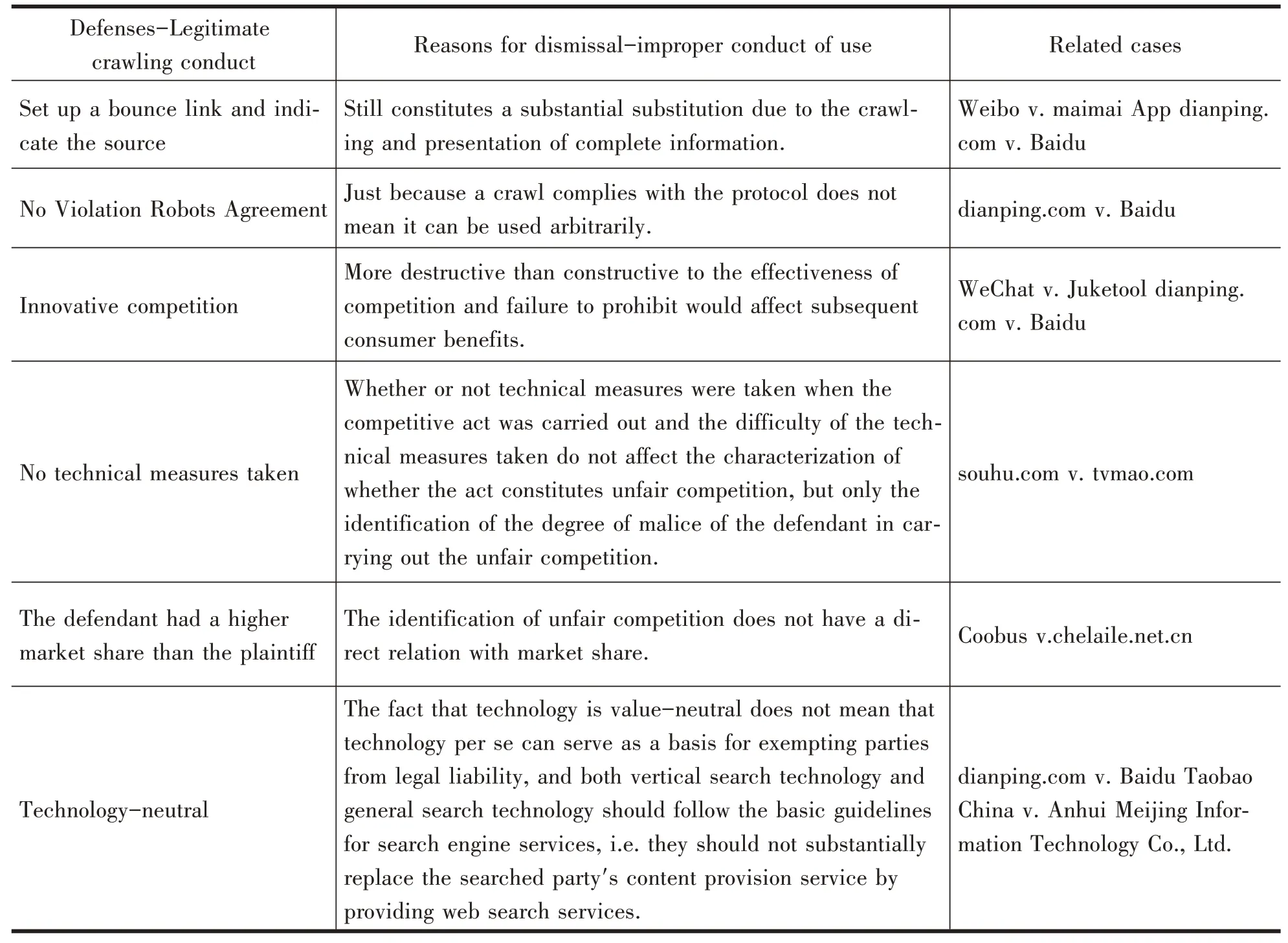
Table 3 Examples of Defenses and Reasons for Dismissal of the Illegality of Data Crawling
4 Conclusion
The special features of data crawling unfair competition cases compared to traditional unfair competition cases in competitive relations,competitive interests,and competitive damages are as follows:with regard to competitive relations,the parties in dispute are often not competitors in the same business;with regard to competitive interests,the legitimacy of the plaintiff's interest in the data must be considered;with regard to competitive damage,we have to consider the separation of data crawling conduct and using conduct.It is also important to consider data sharing and innovation protection which are not found in other unfair competition cases.Therefore,it is suggested that the following specific steps and criteria be adopted when determining data crawling acts of unfair competition in judicial practice:
(1)The threshold issue in any acts of unfair competition is whether there is a direct competitive relation between the parties in dispute.If not,judge whether they have an indirect competitive relation.In this step,the criterion can be the effect of the market substitution,the business model,and the business scope.
(2)The second step is to judge whether the plaintiff has a competitive interest in the data.In this step,one criterion can be the costs paid by the plaintiff in the process of data generation and utilization,and the other criterion can be the legitimacy of obtaining the original data and the legitimacy of the subsequent use of the data.
(3)The third step is to judge the damage caused by the defendant's act of data crawling.In this step,one criterion can be to judge the culpability of the data crawling in combination with whether the subsequent use constitutes a substantial substitution,and the other criterion can be to judge the culpability of the data crawling that constitutes innovative competition according to whether it exceeds the necessary limit and damages the public interest.
Applying the above steps and criteria in data crawling unfair competition cases can fully integrate the particularity of data crawling while realizing the connection with traditional cases,make the referee more targeted,and avoid restricting the circulation and sharing of data and free competition on the basis of reasonably defining unfair competition.
- 科技與法律的其它文章
- “商標(biāo)護(hù)城河”理念的泛化認(rèn)知局限與糾偏
- 司法區(qū)塊鏈的數(shù)智邏輯與訴訟規(guī)訓(xùn)
——以《人民法院在線運(yùn)行規(guī)則》展開(kāi) - 論鼓勵(lì)創(chuàng)新作為《反壟斷法》立法目的
- Interest Balancing Model of Separate Consent to Personal Information
- 從管理到服務(wù):知識(shí)產(chǎn)權(quán)糾紛調(diào)解機(jī)制的模式重塑
- Application of "Green Principles " in the Field of Regional Technological Innovation:A State Intervention Perspective

